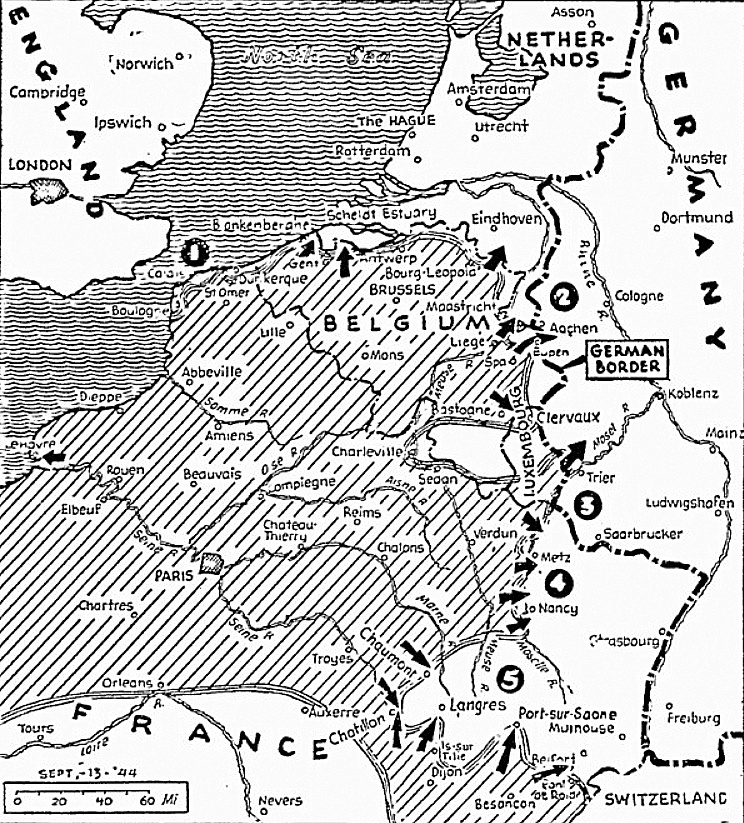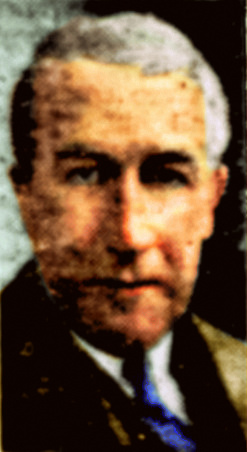The Pittsburgh Press (September 13, 1944)
YANKS TAKE GERMAN TOWN
Bombs rained on Siegfried Line
New U.S. thrusts into Reich indicated; U.S. 9th Army in field
By Virgil Pinkley, United Press staff writer
New invasion of Germany was made by U.S. forces yesterday as they crossed the frontier below Aachen (2), following the initial thrust into the Reich near Trier (3). Hard fighting continued to the south as the U.S. 3rd Army battled from its bridgeheads across the Moselle River (4). Junction of the 3rd Army with the 7th Army was strengthened (5) when French forces reached Châtillon. French and U.S. forces also gained above Dijon and toward the Belfort Gap into Germany. There was no announced change in the British 2nd Army front in northern Belgium, while on the coast (1), British troops captured Le Havre and battled for the other holdout Channel ports.
Bulletin
SHAEF, London, England (UP) –
Dispatches from American-conquered German soil reported tonight that U.S. troops had captured the village of Roetgen – their first specific victory in the Reich – and had overrun a forested height in their drive east from the Eupen area of Belgium. Roetgen is six miles east of Eupen.Lt. Gen. George S. Patton’s 3rd Army lashed out in a newly-announced drive in the Moselle Valley and captured Neufchâteau, 32 miles southwest of Nancy, and raced eastward 27 miles to the Moselle. Forcing a crossing, the Americans were fighting heavily at Charmes on the east bank.
United Press writer Jack Frankish said in a dispatch filed at 11:30 a.m. CET today that the Americans had made the first dent in the Siegfried Line, spearing through the first wall of its frontier crust and driving forward more than a mile and a half.
SHAEF, London, England –
Strong U.S. armored forces, leading a general advance against Germany, reached the Siegfried Line today, while indications grew that other U.S. troops might be pouring across the border in new invasions at unidentified points.
A dispatch from Lt. Gen. Omar N. Bradley’s 12th Army Group headquarters said U.S. tank and infantry forces were in contact with the Siegfried Line, which was taking one of the heaviest aerial poundings of the war from thousands of Allied planes.
The first spearhead was driven against the Siegfried Line, which lies five to 10 miles behind the frontier on the 1st Army front, by one of the armored forces smashing steadily deeper into Germany after crossings from Luxembourg and Belgium, the headquarters dispatch indicated, with advanced elements reaching within some 35 miles of the Rhine River.
A new U.S. army – the 9th Army, commanded by Lt. Gen. William H. Simpson – was revealed to have landed in France to join in the climactic assault on Germany. Its location was not disclosed.
The 12th Army Group headquarters dispatch emphasized that the announcement that the Allies had crossed the German border in “at least” two places – eight miles northwest of Trier and east of Eupen – appeared to imply that other crossings may have been made.
For whatever it was worth in that connection, a Nazi-controlled Oslo broadcast reported crossings east of Malmedy, Belgium, between Trier and Eupen, and southeast of Trier.
Indications were that the Americans would be in close contact with the Siegfried Line at a number of points very soon.
On behalf of Gen. Dwight D. Eisenhower, Allied headquarters broadcast a warning to workers of northwestern, western and southern Germany that “you are in danger.”
Following by 24 hours a warning to the people of the Ruhr and Rhineland that their homes might soon be in the battle area, the new warning said that “in the next few days you may have the greatest opportunities for action” and added:
In a desperate effort to eliminate Allied support among the workers, Himmler plans to repeat in the west what he and the Gestapo have already done in the east. Workers there have been sent to man the fortifications. Thousands have been herded into concentration camps as hostages. Workers in the Ruhr and Rhineland are at this moment under threat of the same danger.
The workers were told to leave the German factories at once and go into hiding, since “the Nazis will not have the men to spare to search for you or to control your movements.”
Headquarters revealed that bombs were dropping on the Siegfried Line and its supporting bases at the rate of six tons a minute, day and night, in a mighty softening-up barrage that thundered into its sixth straight day today.
A blanket of security censorship obscured the advance of the U.S. 1st Army’s two spearheads into Germany south of Aachen and beyond Trier, but correspondents were permitted to reveal that both columns were operating in strength and that new crossings of the border were imminent at six other undisclosed points.
Another great striking arm, the newly-constituted Allied Airborne Army, was also ready to join in the battle for the Nazi homeland. Headquarters refused to comment, however, on a Paris radio report that the paratroopers and glider-borne infantry would soon be landed behind the Siegfried Line to smash the enemy’s communications and transport.
Disclosure that the 9th Army was in the field came as French units of the U.S. 7th Army from the south reached the Seine at Châtillon, 42 miles northwest of Dijon and 93 miles southeast of Nancy, and effected a junction in force with Lt. Gen. George S. Patton’s 3rd Army.
Front dispatches said the U.S. 1st Army spearheads in Germany were pounding steadily eastward against relatively light opposition, probing into the main works of the Siegfried Line. Tanks equipped with great flails moved ahead of the invasion columns of clear away the enemy minefields, while formations of dive bombers streaked in overhead to bomb and machine-gun the retreating enemy.
Latest reports placed one American force about a mile inside the German border beyond Lammersdorf, 10 miles east of Eupen and 12 miles south-southeast of Aachen.
United Press writer Henry T. Gorrell, riding eastward with the invaders, reported that U.S. tanks, troops and guns were streaming into Germany in force, rolling swiftly past sullen German villagers who made no open attempt to interfere.
More than 50 miles to the south, the second invasion column last was reported more than six miles into the Reich after a thrust across the Luxembourg border north of the ancient Teuton city of Trier. The main works of the Siegfried Line at that point lay some 10 to 12 miles east of the frontier and it was indicated that the Yanks were just driving into the fortified belt.
Between the two columns, another 1st Army force captured the Belgian town of Bastogne in the Ardennes Forest and drove forward 13 miles to take Clervaux in Luxembourg, only four miles short of the Nazi frontier.
Malmedy and Spa, southeast of Liège, also fell to the Americans.
Battle near Moselle
On the 1st Army’s southern flank, Gen. Patton’s 3rd Army fought one of the bitterest battles of the campaign along the Moselle River line from Metz to Nancy.
A front dispatch from United Press writer Robert Richards said Gen. Patton was putting additional punching power into a half-dozen bridgeheads on the east bank of the river and the situation was more favorable than at any time since the offensive began.
Mr. Richards said the Germans were drawing reinforcements from other sectors to prevent a breakthrough on the Moselle.
On the British 2nd Army front to the north, the Germans withdrew from the Albert Canal line in Belgium to the Escaut Line, to the north.
Roundabout German reports via Stockholm said the British advanced 18 miles north of the Belgian towns of Petit-Brogel and reached the Eindhoven area, almost 10 miles inside Holland.
Other British units driving eastward through Belgium said to be within four and a half miles of the German border above Maastricht.
Three miles south of Maastricht, a U.S. 1st Army flying column captured the “mystery fort” of Ében-Émael, which the Germans overwhelmed in the first hours of their invasion of the Low Countries more than four years ago.
Capture 7,000
More than 7,000 German prisoners were rounded up in the captured port of Le Havre, after a bloody 36-hour assault by British units of the 1st Canadian Army, but the battle for the other Channel ports continued unabated.
Observers of the British coast reported a thunderous artillery duel was in progress throughout most of last night as the Canadians wheeled hundreds of siege guns up to within point-blank range of Calais, Boulogne and Dunkerque in an effort to blast the Nazis into submission.
Nazi counterattacks repulsed by infantry
With U.S. infantry on the German-Belgian border (UP) – (11:30 a.m. CET)
U.S. infantry units which went into Germany yesterday repulsed a series of small counterattacks throughout the night and retained possession of a forest height.
The infantry penetrated more than a mile and a half inside Germany, crossing the frontier shortly after the armored units.
Lt. Col. Edmund Driscoll of Garden City, New York, commanded the unit which made the greatest penetration. He was believed to have made the first telephone call from Germany, opening his report with: “This is a unit commander speaking from Germany.”


